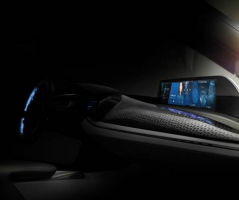
— Distracted driving is a serious and deadly reality for drivers and their passengers, and automakers don't mind installing even more electronic toys to take a driver's eyes off the road. Believing auto buyers need more computerized toys to play with and pay to repair, BMW has announced two technologies that could appear on future models.
One of the technologies will cause distractions while the other could increase safety for drivers and occupants.
BMW AirTouch
Automobiles were created to get someone from point A to point B without doing it on horseback. But today's cars are designed as cabins for entertainment and staying electronically connected to everything outside the cars. The old-time buttons and knobs have been replaced with touchscreens to control phone, entertainment and navigation systems.
The BMW AirTouch uses a screen, but its more like a touchless touchscreen. BMW says the AirTouch is controlled by waving a hand in front of the screen instead of touching it.
The automaker says a driver can control the entertainment, navigation and communication functions using gestures made with a flat hand. AirTouch allows the display in a vehicle to be operated like a touchscreen without actually having to make contact with the surface.
The automaker says sensors record the movements of the hand in the area between the interior mirror and console. BMW says this allows a driver to change the focus on the surface of the large display screen.
And then there is "gesture control," which can already been found in BMW 7 Series cars. This feature enables a movement of a finger to adjust the volume or to accept phone calls.
BMW also says features of AirTouch can "allow the driver to focus all their concentration on the road ahead." The automaker says this is accomplished by bringing up contacts or call lists to the top select level so that a call can be made with just one further option.
How this distraction can actually "allow the driver to focus all their concentration on the road ahead" is anyone's guess.
Mirrorless Cars
Another technology that may be seen in the future and could offer safety benefits to drivers is the mirrorless car. BMW isn't the only automaker pushing the technology but currently it won't be seen on American roads because federal law requires cars to have mirrors.
However, it's still an interesting concept to replace exterior and interior mirrors with cameras and viewing screens.
Using a BMW i8 as an example, the mirrorless car uses two cameras to replace the two (right and left) exterior mirrors. Those cameras are supplemented by a third camera mounted on the upper edge of the rear windscreen. All images from the cameras are merged and displayed as a single image on a display suspended in the position of the interior rear-view mirror.
Traffic behind the car can be displayed on a greater viewing area compared to what is possible with standard mirrors. Along with the rear-view mirror being eliminated, with cameras there are no blind spots like those commonly found on standard mirrors.
BMW also says the interior display screen can signal a driver to nearby hazards. For example, if a driver is about to turn right at traffic lights, the system recognizes the car is turning a corner by the indicators flashing or the steering wheel being turned sharply. The image in the display automatically swivels to the right and extends the area being displayed.
If a cycle rider approaches from the rear, a warning signal is illuminated in the display as well.
BMW says the cameras will never need to be adjusted, but the automaker didn't say what the potential cost is, or what it would cost to replace the cameras or viewing screen.




